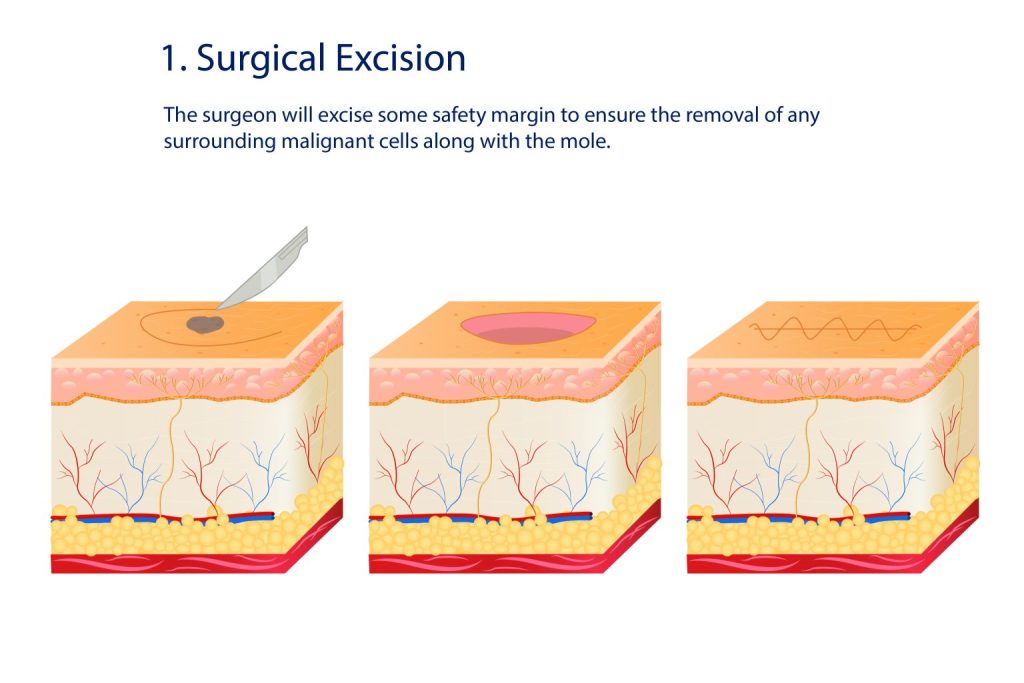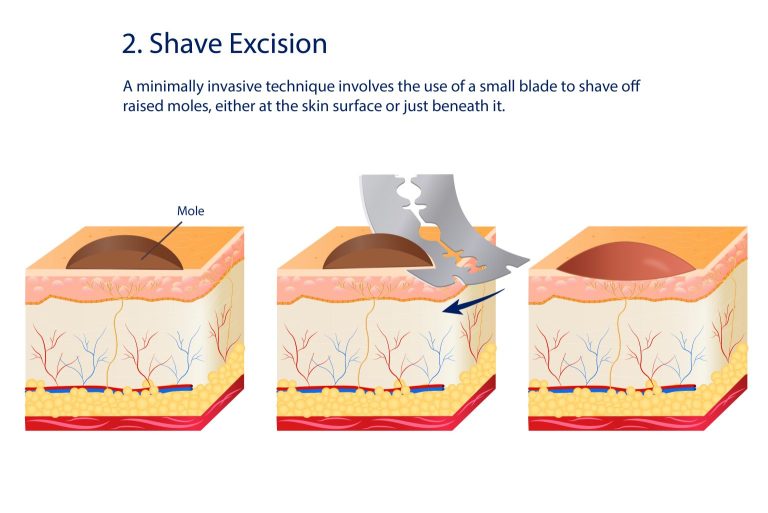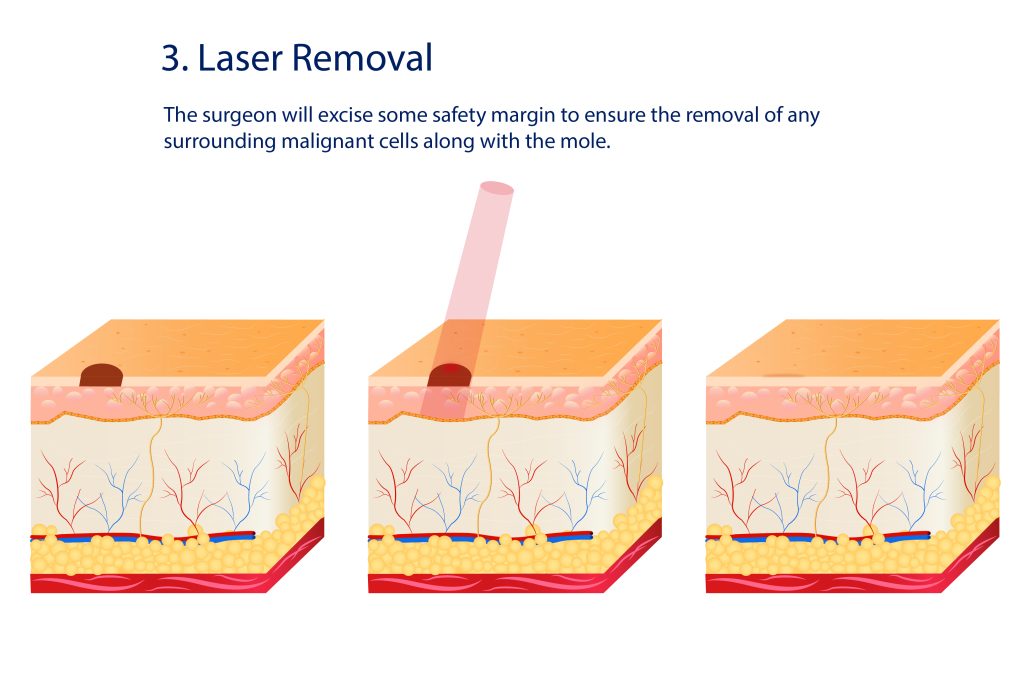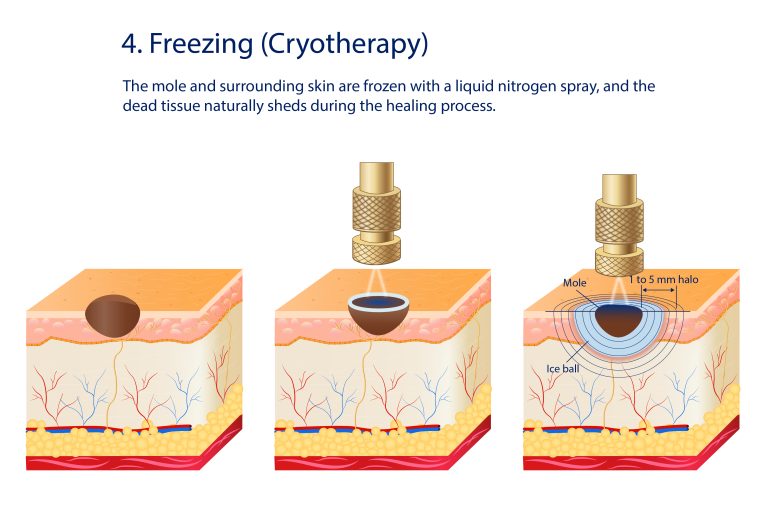
Removal Of Skin Lesions – Moles, Skin Tags & Skin Growths
Rid unwanted moles, lumps & bumps.

Procedure Time
1 Hour

Anaesthesia
Local Anaesthesia or Sedation

Recovery Period
7 – 10 Days

Stitch Removal
7 Days of Post-op
What Is Mole Removal

Moles are skin growths caused by clusters of pigmented cells known as melanocytes. They are usually harmless and can vary in shape, size, and colour, commonly appearing as small, round spots that are black or brown. Moles may develop or fade over time and can appear on any part of the body.
What Causes Moles To Grow?
Moles can develop and grow due to a variety of factors. Primarily, they are caused by the clustering of pigment-producing cells called melanocytes. While some moles are present from birth, many others appear during childhood or adolescence. Several factors can trigger the growth of moles, including:
- Genetics: A family history of moles can increase your likelihood of developing them. Genetics play a role in determining their size, shape, and location.
- Sun Exposure: Ultraviolet (UV) rays from the sun or tanning beds can stimulate melanocytes, leading to new mole formation or darkening of existing moles, especially on sun-exposed areas like the face and arms.
- Hormonal Changes: Periods of hormonal shifts, such as puberty or pregnancy, may cause moles to appear, darken, or grow.
- Ageing: Moles can continue to change over time, and new ones may develop with age. Regular monitoring is important to identify any unusual changes that might require medical attention.
Protecting your skin from sun exposure and keeping track of mole changes are key steps to ensure they remain benign.
Who Needs Mole Removal
Mole removal is a common procedure sought for both medical and cosmetic reasons. While most moles are harmless, there are certain instances where removal may be necessary or recommended. Here are some scenarios where mole removal might be considered:
Suspicion of Skin Cancer
If a mole shows signs of being cancerous or precancerous, removal becomes necessary. Changes in size, shape, colour, or irregular borders should prompt an evaluation by a doctor. Characteristics such as asymmetry, uneven edges, colour variations, or rapid growth may indicate melanoma and require immediate removal and testing to confirm or rule out cancer.
Cosmetic Reasons
Moles can also be removed for cosmetic reasons. If a mole is located in a prominent area, such as the face or neck, or if its appearance leads to self-consciousness, cosmetic mole removal may be considered.
Physical Discomfort
Moles that are raised, large, or located in areas prone to friction — such as the underarms, waistline, or neck — can cause irritation and discomfort. They may catch on clothing or accessories, interfering with daily activities and leading to the consideration of removal.
Risk of Trauma
Moles located in high-risk areas that are frequently bumped or scratched may need to be removed to prevent injury or bleeding. Constant trauma to a mole can increase the risk of infection or other complications, making removal a practical choice.
Changes in Appearance or Symptoms
If a mole begins to itch, bleed, or become painful, it is important to seek medical advice. Such changes could indicate underlying health concerns and may require removal for further evaluation.
Common Methods Of Mole Removal In Singapore
Moles can be removed through various techniques, depending on their size, location, and whether they are suspected to be cancerous. Common methods include:
Surgical Excision
This process involves cutting out the entire mole and a surrounding margin of healthy skin. The area is then stitched closed to facilitate healing.


Shave Excision
This technique is suitable for protruding moles. The surgeon uses a small blade to shave off the mole, leaving the area to heal naturally.
Laser Removal
Some moles can be treated with laser therapy, where focused light is used to break down the mole’s pigment. This method is often preferred for smaller and non-cancerous moles.


Freezing (Cryotherapy)
Cryotherapy involves freezing the mole with liquid nitrogen, causing it to fall off over time.
Price Of Mole Removal In Singapore
The cost of mole removal in Singapore depends on factors such as the size, complexity, and location of the mole, as well as the method used for removal. Surgical mole removal typically costs more than laser mole removal due to the procedure’s complexity.
To get an accurate estimate, it is recommended to schedule a consultation with a surgeon. During the assessment, they can provide detailed information about the costs and help you decide on the most suitable option for your mole removal.
Frequently Asked Questions (FAQ) about Mole Removal in Singapore
What are signs of a suspicious or cancerous mole?

Some signs to look out for that indicate a suspicious or cancerous mole include:
A – Asymmetry
B – irregular Borders
C – change in Colour
D – Diameter over 6mm
Depending on the clinical diagnosis of your mole or skin lesion, our plastic surgeons will advise you accordingly on whether you should have it removed.
How do I care for my skin after mole removal?
After care for your skin after your mole removal procedure is simple, you just need to be diligent and religiously apply both silicone scar cream and sunblock. This is important to ensure that the scar stays as flat as possible and prevents any pigmentation from occurring due to sun damage while the skin is vulnerable. Some individuals may require steroid injections or laser scar therapy to improve the appearance of their scar and make it less noticeable if that is necessary of a concern.
It is also important to apply sunblock whenever you go outside for several months, as the area of mole removal is more sensitive to the sun. If the scar is small and you intend to spend time out in the sun, some people find using a small plaster beneficial.
Mole Removal Downtime: How much rest is required after having mole removal?
Mole removal downtime is relatively minimal. After your local anaesthetic has worn off, you will find that you feel a little pain and discomfort, but this can be reduced with off-the-shelf painkillers. Depending on your job, it is recommended that you take a day or two off work as you may find there to be some swelling and/or bruising where your mole was removed, although this will fade over the course of about a week.
Even with the use of a local anaesthetic you should still be able to take yourself home from your appointment. Your surgeon will let you know during your assessment appointment if they think you need another person to take you home for any reason.
Can my mole removal be covered by insurance?
If the mole is removed for medical reasons, such as suspicion of cancer or other health concerns, it may be eligible for coverage under health insurance plans. However, if the removal is solely for cosmetic reasons, it is usually not covered. To confirm eligibility, it is recommended to consult your insurance provider and seek a medical evaluation.
Is it likely that my mole will grow back after removal?
There is a slight chance that a mole may regrow after removal if a small number of melanocyte cells remain in the skin. However, this occurrence is uncommon. If your mole does return after the initial procedure, we will gladly arrange a follow-up appointment to ensure it is fully removed.
How do I know if I need to have my mole or skin lesion removed?
Our surgeons may recommend removing a mole or skin lesion if there are concerns it could be cancerous or if there is a potential risk of it becoming cancerous over time. In some cases, benign (non-cancerous) moles or lesions may appear similar to skin cancer, and the only definitive way to confirm whether it is cancerous is to remove it and perform a biopsy.
Moles or skin lesions that are benign and show no signs of becoming cancerous do not usually require removal and can simply be monitored. However, if a mole or lesion causes discomfort—such as catching on clothing—or if you are unhappy with its appearance, you may choose to have it removed.
